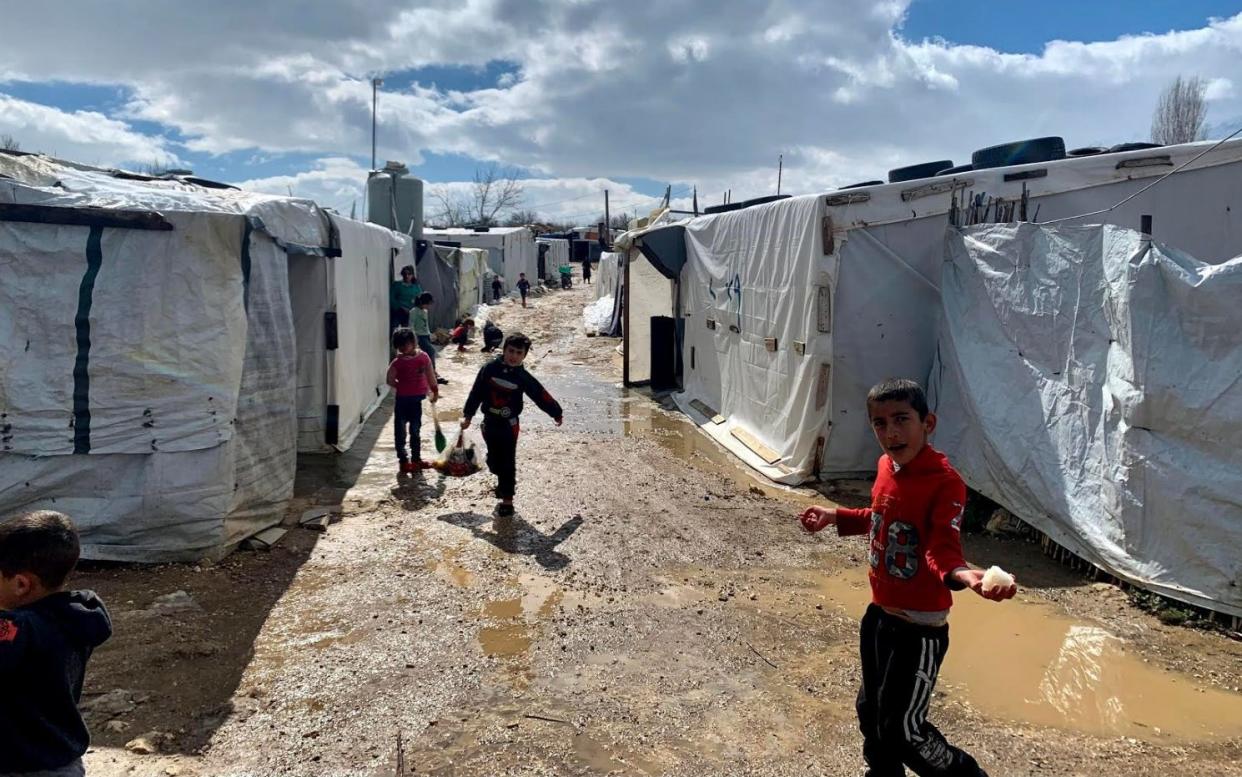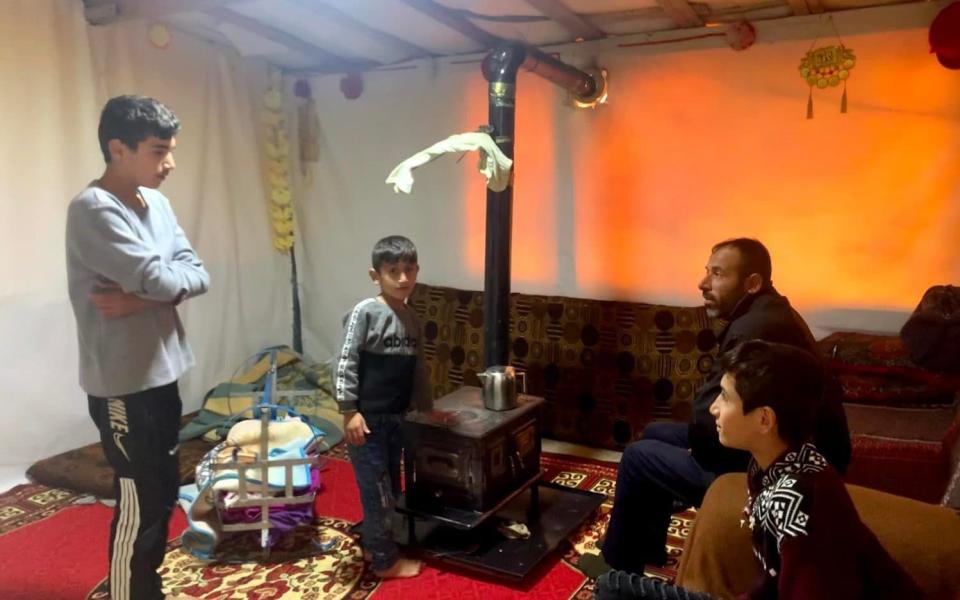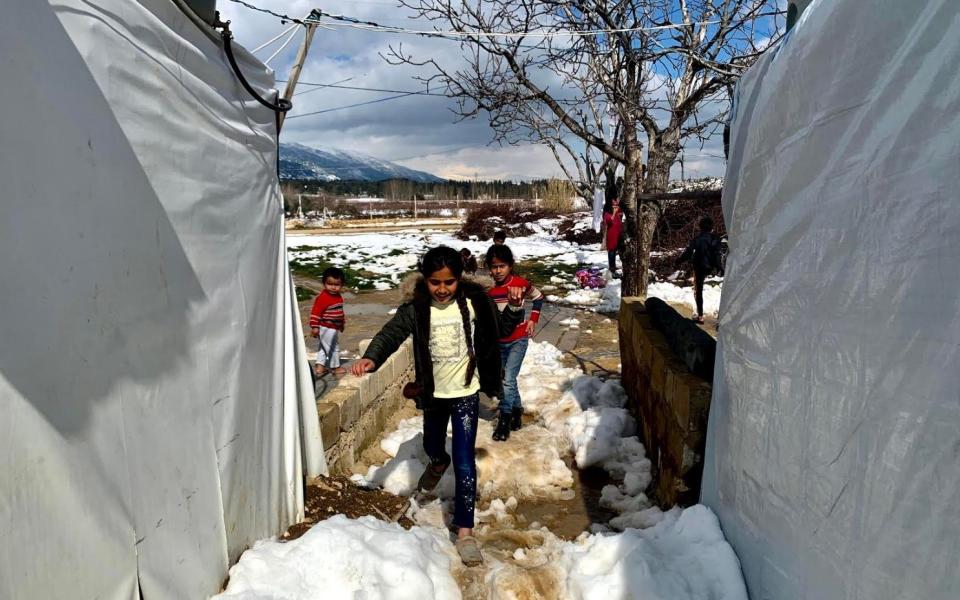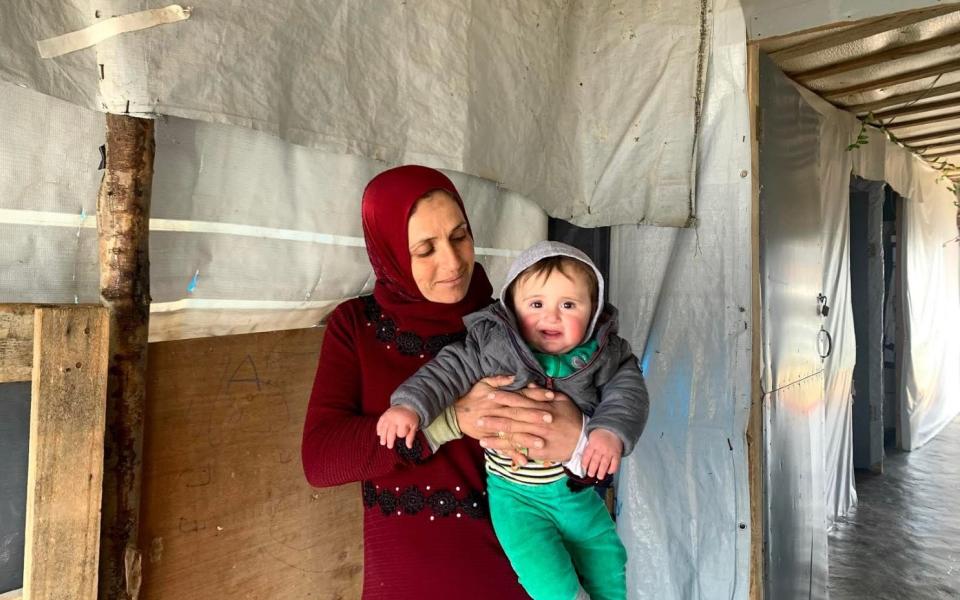‘I might not go back to school’: childhood dreams fade as poverty forces Lebanon’s young into work

Nawaf starts his working day at 5am. The 15-year-old spends eight hours lugging 10kg trays of fruit from the field where they are being picked to a warehouse a few hundred metres away. Then, tired and aching, he heads home to change before his school day starts in the afternoon.
“It’s exhausting but I try my best because I love school and I really want to continue. My dream is to graduate university and become a nurse,” he said. “But I might not be able to go back to school next year.”
As a Syrian refugee in crisis-riddled Lebanon, Nawaf’s dreams are quickly fading away.
The smart teenager with a cheeky grin and unparalleled pride over his first moustache disappeared to another room when his mother began to explain that she may not be able to send him back to school next year. The UN will stop funding Nawaf's education next academic year and the soaring cost of living in Lebanon means his parents will be unable to pay for it.
Over the past year Lebanon’s economic crash has driven over half of the population into poverty and nine in 10 of its approximately 1.5 million Syrian refugees into extreme poverty. As a result, increasing numbers of children are having to work to stop their families facing eviction and hunger.

Despite unemployment soaring among both refugees and Lebanese, the number of children who are working is increasing across both groups.
“Children mostly continued working throughout the pandemic,” said Dima Wehbi from the International Rescue Committee’s Lebanon office. “We suspect it's because it was easier for them to move around and it was less of a risk that they would get fined [for breaking lockdown restrictions]. It’s another reason why children have been at heightened risk from working throughout the pandemic: there was no protection for them at all”.
For a gruelling eight hour shift, Nawaf earns LL10,000, which on the current black market rate is the equivalent to $1. With no school in session because of the pandemic, Nawaf’s 13-year-old younger brother also spent his first season working the fields this year so that the family could afford to eat.
Inflation in Lebanon hit a staggering 84.9 per cent in 2020, rising from 2.9 per cent in 2019. For Lebanon’s numerous vulnerable communities, food became increasingly expensive as inflation in this sector hit over 400 per cent. However, wages mostly stayed the same.
Food security for Syrian refugees “witnessed drastic deterioration” in 2020, according to the UN Refugee Agency (UNHCR). Nearly half – 49 per cent – of Syrian refugee households were food insecure, up by 20 per cent compared to 2019. And this year is unlikely to be any easier.
In the Beqaa Valley, where Nawaf and his family live, 96 per cent of Syrian refugees are living in extreme poverty, according to UNHCR. The extreme poverty line is currently defined at each person living on less than LL308,728 (£21.90) per month.
Nawaf is fortunate that he works on the same land as his father and doesn’t face violence and exploitation from his employer. Across the country, many are less lucky.
It is only the one or two dollars that Nawaf and his brother bring home from work that provides for the family. Nestled in a tented community in the Beqaa Valley, the story is the same for more than 30 families living in Kherbet Qanafar.

All the men work in the fields in the summer, earning LL20,000 per day, but their wages do not go into their pockets: it goes straight back to the landowner to pay the rent for their tents - an amount that they do not earn enough to cover, let alone buy food or clothes.
So parents have no choice to send their teenage children out to work.
Throughout the winter while there is no work in the fields, the families – who have all lived in the same tents for eight years since they fled their village in Idlib, a rebel-held bastion of Syria – have to borrow from the landowner to survive. They are all caught in a vicious cycle of debt bondage, yet there is still never enough food or heat.
Ninety-two per cent of Syrian refugee households are in debt, with 93 per cent reporting that the top reason they were borrowing money was so they could buy food, a recent UNHCR survey found.
In recent years most of the child labour in Lebanon has been carried out by Syrians, but now increasing numbers of Lebanese families are having to resort to sending their underage children to work so that basic expenses such as rent and food can be met.
The latest official data on child labour in Lebanon, outside that coming from refugee agencies, was in 2016, four years before Lebanon’s biggest economic crisis. It showed that between 2009 and 2016 child labour in the country – of all nationalities – had tripled, with around 100,000 children working. The 2020 house-to-house survey was postponed due to the pandemic, Unicef said.
“We know that these numbers are no longer accurate, child labour has definitely increased because of Lebanon’s multiple crises from the economy, to instability, to the Covid pandemic, to the Beirut explosion. All of these things made 2020 exceptionally challenging. It was a year of deterioration of the wellbeing of the most vulnerable people,” said Raquel Fernandez at Unicef.
According to the UN Refugee Agency, the number of Syrian refugees engaged in child labour doubled in 2020, up to 4.4 per cent.
“We can safely say the number of Lebanese children engaging in child labour is really increasing. We can also safely say, unfortunately, that it is expected to continue to increase in this protracted crisis… especially when the lockdown restrictions start relaxing and it becomes more visible,” Ms Fernandez said.
According to child protection officers at the Danish Refugee Council, more than 80 per cent of the Lebanese and Syrian children that they work with who are engaged in child labour are not attending any form of education, primarily because they work. For those who are attempting to take part in online education, Lebanon’s infamously slow yet expensive internet is standing in the way.
“My kids are trying but it takes three hours to load one of the videos and if the electricity cuts it has to start again,” said Khaled Assaid in the Qanafar camp.
For 12-year-old Warde, who begs on the streets of Beirut, the idea of going to school has always been a far-off dream. For as long as she can remember she, her four siblings and mother would split up in the mornings to try and collect the things they needed to survive from different areas of Lebanon. For the most part, the children beg in the streets while their mother scouts through bins to find clothes for the family.
Since the value of the Lebanese lira collapsed and food inflation began to soar last year, the family can't afford both rent and food, having to resort to informal loans and limited meals. With no end in sight to Lebanon’s economic collapse life is only getting harder for the family of five.
With the construction industry closed for elongated periods during lockdown, a visible rise in children working on the streets - begging, sorting through rubbish, collecting metals and plastics to sell - has been seen across the country in recent months.

“Every day we have more families who cannot afford their wellbeing and protection, so every day more children at risk of these negative coping mechanisms: child labour, exploitation, child marriage… they are all on the rise since last year,” said Ms Fernandez.
“If children are not involved in school, this cycle of child abuse and child exploitation immediately starts to affect children in all forms: whether it’s an increase in child marriage, an increase in child abuse, an increase in domestic violence against children or an increase against child labour: it’s a circle, they all go together.”
As often comes hand-in-hand with a rise in child labour and poverty, child marriage is also expected to rise.
“In focus group discussions we’ve had, some parents said that they were having to resort to child marriage as a coping mechanism due to the harsh economic conditions and their inability to provide for their families any more,” said UNHCR’s Lisa Abou Khaled, citing a six per cent rise in child marriage in the third quarter of 2020.
“In some parts of the country, agencies are saying that the age group of those who are getting married has changed, Ms Abou Khaled added. “Parents are resorting to the marriage of their daughters at a younger age… 13 to 14 years old, compared to 2019 when the average of married girls was between 16 and 17”.
Her colleague, Raquel Fernandez, agrees. “If the situation continues… the deepening and worsening of the economic situation for the most vulnerable families, of course, the immediate risk for these children is exclusion and marginalisation,” she said.
Protect yourself and your family by learning more about Global Health Security

